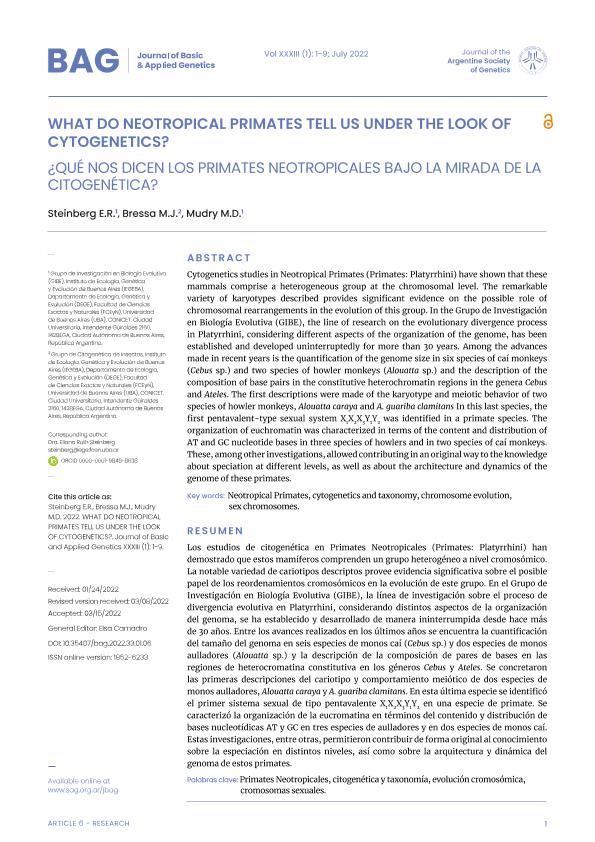Artículo
Los estudios de citogenética en Primates Neotropicales (Primates: Platyrrhini) han demostrado que estos mamíferos comprenden un grupo heterogéneo a nivel cromosómico. La notable variedad de cariotipos descriptos provee evidencia significativa sobre el posible papel de los reordenamientos cromosómicos en su evolución. En el Grupo de Investigación en Biología Evolutiva (GIBE), la línea de investigación sobre el proceso de divergencia evolutiva en Platyrrhini considerando distintos aspectos de la organización del genoma se ha establecido y desarrollado de manera ininterrumpida desde hace más de 30 años. Entre los avances realizados en los últimos años se encuentra la cuantificación del tamaño del genoma en seis especies de monos caí (Cebus sp.) y dos especies de monos aulladores (Alouatta sp.) y la descripción de la composición de pares de bases en las regiones de heterocromatina constitutiva en los géneros Cebus y Ateles. Se concretaron las primeras descripciones del cariotipo y comportamiento meiótico en profase I temprana de dos especies de monos aulladores, Alouatta caraya y A. guariba clamitans. En esta última especie se identificó el primer sistema sexual de tipo pentavalente X1X2X3Y1Y2 en una especie de primate. Se caracterizó la organización de la eucromatina en términos del contenido y distribución de bases nucleotídicas AT y GC en tres especies de aulladores y en dos especies de monos caí. Estas investigaciones, entre otras, permitieron contribuir de forma original al conocimiento sobre la especiación en distintos niveles, así como sobre la arquitectura y dinámica del genoma de estos primates. Cytogenetics studies in Neotropical Primates (Primates: Platyrrhini) have shown that these mammals comprise a heterogeneous group at the chromosomal level. The remarkable variety of karyotypes described provides significant evidence on the possible role of chromosomal rearrangements in their evolution. In the Grupo de Investigación en Biología Evolutiva (GIBE), the line of research on the evolutionary divergence process in Platyrrhini considering different aspects of the organization of the genome has been established and developed uninterruptedly for more than 30 years. Among the advances made in recent years is the quantification of the genome size in six species of caí monkeys (Cebus sp.) and two species of howler monkeys (Alouatta sp.) and the description of the composition of base pairs in the constitutive heterochromatin regions in the genera Cebus and Ateles. The first descriptions were made of the karyotype and meiotic behavior in early prophase I of two species of howler monkeys, Alouatta caraya and A. guariba clamitans. In this last species, the first pentavalent-type sexual system X1X2X3Y1Y2 was identified in a primate species. The organization of euchromatin was characterized in terms of the content and distribution of AT and GC nucleotide bases in three species of howlers and in two species of caí monkeys. These, among other investigations, allowed contributing in an original way to the knowledge about speciation at different levels, as well as about the architecture and dynamics of the genome of these primates.
¿Qué nos dicen los primates neotropicales bajo la mirada de la citogenética?
Título:
What do neotropical primates tell us under the look of cytogenetics?
Fecha de publicación:
10/2022
Editorial:
Sociedad Argentina de Genética
Revista:
Basic and Applied Genetics
ISSN:
1666-0390
e-ISSN:
1852-6233
Idioma:
Español
Tipo de recurso:
Artículo publicado
Clasificación temática:
Resumen
Archivos asociados
Licencia
Identificadores
Colecciones
Articulos(IEGEBA)
Articulos de INSTITUTO DE ECOLOGIA, GENETICA Y EVOLUCION DE BS. AS
Articulos de INSTITUTO DE ECOLOGIA, GENETICA Y EVOLUCION DE BS. AS
Citación
Steinberg, Eliana Ruth; Bressa, Maria Jose; Mudry, Marta Dolores; ¿Qué nos dicen los primates neotropicales bajo la mirada de la citogenética?; Sociedad Argentina de Genética; Basic and Applied Genetics; 33; 1; 10-2022; 97-105
Compartir
Altmétricas




